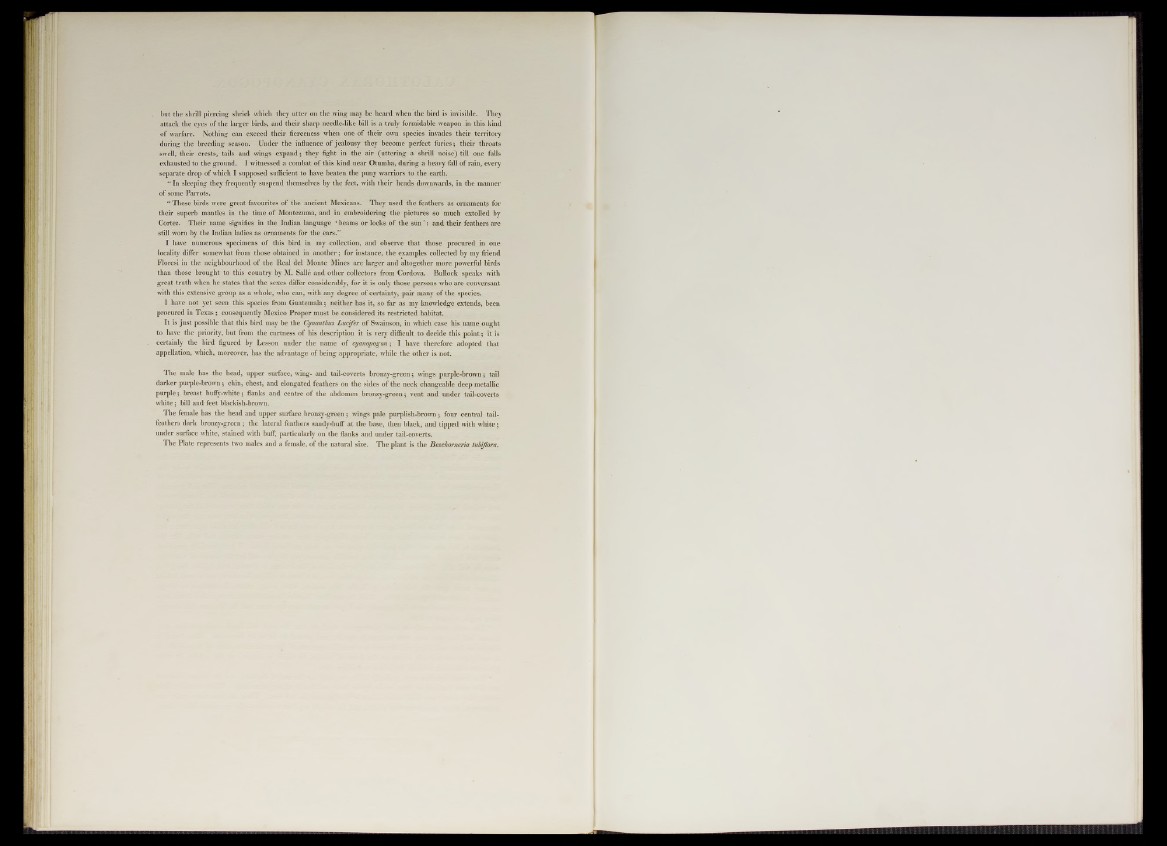
but the shrill piercing shriek which they utter on the wing may be heard when the bird is invisible. They
attack the eyes of the larger birds, and their sharp needle-like bill is a truly formidable weapon in this kind
of warfare. Nothing can exceed their fierceness when one of their own species invades their territory
during the breeding season. Under the influence of jealousy they become perfect furies; their throats
swell, their crests, tails and wings expand; they fight in the air (uttering a shrill noise) till one falls
exhausted to the ground. I witnessed a combat of this kind near Otumha, during a heavy fall of rain, every
separate drop of which I supposed sufficient to have beaten the puny warriors to the earth.
“ In sleeping they frequently suspend themselves by the feet, with their heads downwards, in the manner
of some Parrots.
“ These birds were great favourites of the ancient Mexicans. They used the feathers as ornaments for
their superb mantles in the time of Montezuma, and in embroidering the pictures so much extolled by
Cortez. Their name signifies in the Indian language ‘ beams or locks of the sun ’ : and their feathers are
still worn by the Indian ladies as ornaments for the ears.”
I have numerous specimens of this bird in my collection, and observe that those procured in one
locality differ somewhat from those obtained in another; for instance, the examples collected by my friend
Floresi in the neighbourhood of the Real del Monte Mines are larger and altogether more powerful birds
than those brought to this country by M. Salle and other collectors from Cordova. Bullock speaks with
great truth when he states that the sexes differ considerably, for it is only those persons who are conversant
with this extensive group as a whole, who can, with any degree of certainty, pair many of the species.
I have not yet seen this species from Guatemala; neither has it, so far as my knowledge extends, been
procured in Texas; consequently Mexico Proper must be considered its restricted habitat.
It is just possible that this bird may be the Cynanthus Lucifer of Swainson, in which case his name ought
to have the priority, but from the curtness of his description it is very difficult to decide this point; it is
certainly the bird figured by Lesson under the name of cyanopogon; I have therefore adopted that
appellation, which, moreover, has the advantage of being appropriate, while the other is not.
The male has the head, upper surface, wing- and tail-coverts bronzy-green; wings purple-brown; tail
darker purple-brown; chin, chest, and elongated feathers on the sides of the neck changeable deep metallic
purple; breast buffy-white; flanks and centre of the abdomen bronzy-green; vent and under tail-coverts
white; bill and feet blackish-brown.
The female has the head and upper surface bronzy-green; wings pale purplish-brown ; four central tail-
feathers dark bronzy-green; the lateral feathers sandy-buff at the base, then black, and tipped with white;
under surface white, stained with buff, particularly on the flanks and under tail-coverts.
The Plate represents two males and a female, of the natural size. The plant is the Beschorneria tubiflora.